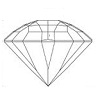16.45: Cianita
( \newcommand{\kernel}{\mathrm{null}\,}\)
| Cianita | |
|---|---|
| Composición química | Silicato de Aluminio Al 2 Si0 5 |
| Sistema de cristal | Triclínica |
| Hábito | Palas alargadas o columnares. |
| Escote | Perfecto y bueno/sin par |
| Fractura | Desigual |
| Dureza | 4 - 7.5 |
| Naturaleza óptica | Biaxial - |
| Índice de refracción | 1.710- 1.734 |
| Birrefringencia | 0.017 |
| Dispersión | 0.020 |
| Gravedad específica | 3.65 - 3.68 |
| Lustre | Vítreo |
| Pleocroísmo | Moderada a Fuerte, Tricróica |

Figura16.45.1: Cianita facetada
Foto cortesía de The Gem Trader
La cianita es un silicato de aluminio con la fórmula química Al 2 SiO 5. Su nombre deriva de la palabra griega “kyanos” que significa azul.
El color es de azul a incoloro, azul-verde y marrón con un brillo vítreo.
La cianita junto con la andalucita y la silimanita, todas las piedras preciosas, pertenecen a la misma familia polimórfica. Todos son silicatos tetraédricos aislados y tienen la misma fórmula química pero tienen estructuras claramente diferentes.
La cianita es un mineral metamórfico que se presenta en esquistos, gneis y pegmatitas de granito. Los minerales asociados son cuarzo, feldespato, mica, granate, corindón y estaurolita.
La cianita se presenta como cristales triclínicos con hojas y tabulares. El hermanamiento lamelar es común. Tiene dos direcciones de escote, una perfecta y la otra buena-desigual. Tiene dureza direccional con 4 en la dirección del eje c y 7.5 en ángulo recto con respecto al eje C.
Localidades: Brasil, Kenia, Mocambique, Noruega, Myanmar, Austria, Suiza etc.
Sinónimos: Cianita, Disthene.
Diagnóstico
La cianita puede confundirse con:
Diafanidad
Transparente a translúcido.
Color
La cianita es alocromática y se presenta en los colores azul a incoloro, azul-verde, marrón y naranja.
La variedad azul es la más utilizada como gema.
La causa del color es hierro y titanio para las piedras azules (transferencia de carga de Fe 2+ —> Ti 4+) y vanadio para las verdes. Las piedras anaranjadas son probablemente coloreadas por hierro y/o manganeso.
Dureza
La cianita tiene dureza direccional con 4 a 5.5 en la dirección del eje c y de 7 a 7.5 en ángulo recto con respecto al eje C.
Escote
La ciantita tiene un escote perfecto a lo largo de una dirección prisma {100} y una buena escisión a lo largo del plano {010}. También tiene separación basal {001}.
Racha
Blanco.
Refractómetro
n α = 1.710 - 1.718, n β = 1.719 - 1.724, n γ = 1.724 - 1.734 con una birrefringencia de 0.012 a 0.017.
Naturaleza óptica: biaxial negativa.
Pleocroísmo
De moderado a fuerte (débil en piedras anaranjadas).
Piedras azules: incoloras, azules, azul oscuro.
Luminiscencia
LW-UV: rojo débil.
Espectroscopio

Figura16.45.2: Espectro de cianita verde y algo azul
La cianita azul puede mostrar dos líneas en el azul con un corte general en el violeta. Otras líneas en rojo y rojo intenso se pueden ver en cianita verde azulado.
Líneas de absorción: (706), (689), (671), (652), 445, 435.
Observe que la imagen se asemeja al “complejo 450” del zafiro rico en hierro. En esta imagen se muestran las líneas de 445 y 435 nm así como el corte en el violeta.
Para las piedras anaranjadas, puede haber una línea en 553 y una absorción general en el azul-verde/azul.
Gravedad específica
La cianita puede tener una gravedad específica de 3.53 a 3.68, pero para el material de gema suele estar en la región superior de 3.67. Se hunde en todos los líquidos pesados comunes.
Ampliación
- Zonificación de color fuerte
- Agujas paralelas
- Plumas líquidas
Durabilidad
Debido a su perfecto a buen escote a lo largo de los planos prismáticos {100} y {010}, la piedra debe ser protegida de ser golpeada en la dirección de las caras prismáticas. También muestra una buena separación a lo largo del plano basal {001}.
Además, la dureza relativa de 4-5.5 en la dirección de las caras del prisma hace que sea aún menos candidato para ser engastado en piezas de joyería que son propensas a la abrasión, como anillos.
Fenómenos
Se reporta chatoyancia, pero rara.
Fuentes
- Gemas Sus Fuentes, Descripciones e Identificación 4ª Edición (1990) - Robert Webster (6a ed.)
- Piedras preciosas del mundo, 3ª edición Rev Exp (2006) - Walter Schuman ISBN 1402740166
- Mineralogía segunda edición (2002) - Dexter Perkins ISBN 0130620998
- Guía de referencia de gemas (1995) - GIA ISBN 0873110196
- FlashData #25: Naranja cianita Tanzanie - J.-M. Arlabosse, 2008


